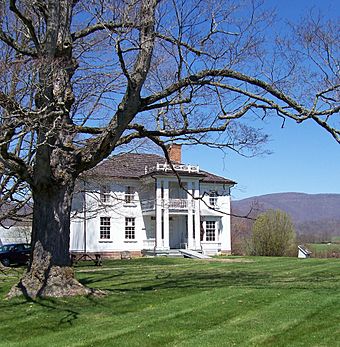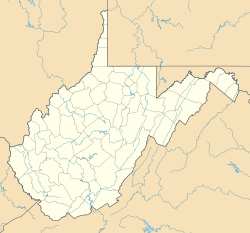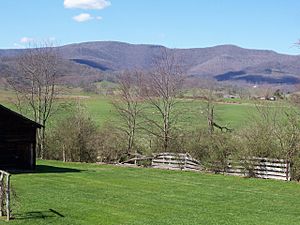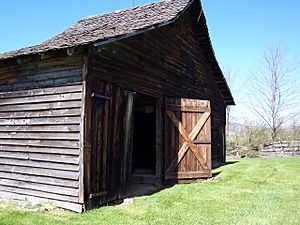Pearl S. Buck Birthplace facts for kids
Quick facts for kids |
|
|
Pearl Buck House
|
|

The Pearl S. Buck Birthplace
|
|
| Location | 8129 Seneca Trail, Hillsboro, West Virginia |
|---|---|
| Area | 16.4 acres (6.6 ha) |
| Built | 1892 |
| NRHP reference No. | 70000663 |
| Added to NRHP | June 15, 1970 |
The Pearl S. Buck Birthplace is a special historic home in Hillsboro, West Virginia. It's where the famous American writer Pearl S. Buck was born. Today, it's a museum where you can take guided tours and learn about her life.
The site also has a carpentry shop and a barn filled with old farm tools. You can also see the log home of Pearl Buck's father's family, the Sydenstrickers, which was moved here from Greenbrier County.
Contents
Discovering Pearl S. Buck's History
This three-story house was built around 1875. It was constructed by hand by a Dutch family who came to America to escape religious problems in the Netherlands. Pearl S. Buck was born here in 1892. Her parents, Caroline Stulting and Absalom Sydenstricker, were Presbyterian missionaries in China. They were visiting America when Pearl was born and returned to China three months later.
Pearl S. Buck became a world-famous author. She was the first American woman to win both the Pulitzer Prize (in 1932 for her book The Good Earth) and the Nobel Prize for Literature (in 1938). She wrote over 100 books, plus many short stories and articles. Her books have been translated into 69 different languages!
Protecting the Pearl S. Buck Home
Pearl S. Buck herself cared a lot about saving and fixing up her birthplace. She wanted it to be a place for everyone, not just her family. She hoped it would inspire new thoughts and dreams for visitors.
The house is open for public tours, so you can visit and explore it. Because of its importance, the site was added to the National Register of Historic Places on June 15, 1970.
Pearl Buck's Original Writings
Pearl Buck gave her valuable collection of original writings, called manuscripts, to the Birthplace Foundation in 1970. These important documents are currently kept safe at West Virginia Wesleyan College. They will stay there until a special building is ready for them at the Birthplace. Researchers can study them with permission from the foundation.
The Stulting Family Home
Pearl Buck's mother's family, the Stultings, moved from Utrecht, the Netherlands, in 1847. They came with many friends and relatives to find a place where they could practice their religion freely. They settled in West Virginia, which was then part of Virginia.
Pearl S. Buck's great-grandfather, Cornelius "Mynheer" Stulting, dreamed of building a house like the one they had in the Netherlands. He wanted to help his wife, Arnolda, feel more at home in America. The Stulting men worked hard, using materials from the land. Cornelius "Mynheer" sadly passed away before the house was finished. His son, Hermanus, and grandson, Cornelius John, completed the large, twelve-room wooden house.
Pearl Buck's mother, Caroline, grew up in this house. She married Absalom Sydenstricker, and soon after, they left for China to become missionaries. They were pioneers, often living in towns where no other white families lived.
The Sydenstrickers visited this home often during their breaks from China. It was during one of these visits that Pearl Comfort Sydenstricker was born here on June 26, 1892. Even though she spent her childhood in China, Pearl loved this American home. Her mother had shared many stories about it with her.
The Stulting family lived in and enjoyed the house until 1922. Later, Mr. Jim Comstock bought the home to save it for its historical value. With help from donations, the West Virginia Federation of Women's Clubs took over its purchase and restoration.
The Stulting Barn
Even though the Stulting family wasn't experienced in farming when they arrived, they managed to make a living on their small farm. The barn you see today has been restored to look just as it did in 1892. This restoration was completed in 1977 and the barn is also listed on the National Register of Historic Places.
Today, the barn is filled with old farm tools and equipment. It has a hayloft, stalls, and storage areas, showing what a typical farm barn looked like in the late 1800s.
The Sydenstricker Family Home
This house was a gift to the Birthplace Foundation. It was moved from its original location and rebuilt in Hillsboro. It was the birthplace of Pearl's father, Dr. Absalom Sydenstricker. He was a Presbyterian missionary in China for his entire adult life.
The original part of the house is made of logs. It now serves as a museum for items from the Sydenstricker family and the time period of 1834–1880. The house was built in 1834 by Andrew Sydenstricker, Pearl's grandfather. Five of Andrew's sons became ministers.
The Sydenstricker family was very important in Greenbrier County. Pearl S. Buck's great-great-grandfather, Philip Sydenstricker, came to America from Bavaria (Germany) in 1764. He settled on a farm near Ronceverte, Greenbrier County.
The house was originally a two-story log cabin. Later, siding was added to match new parts of the house as the family grew. During its reconstruction, the siding was removed to show the original logs. The house was completed in 1982 with the help of grants and donations. The Pearl Buck Birthplace Foundation is still looking for donated items, especially furniture and memorabilia from the Sydenstricker family, for this house.
Pearl S. Buck Memorial Garden
The farm around the Birthplace is being turned into a beautiful Memorial Garden to honor Pearl Buck. The project started by restoring a fruit orchard with old-fashioned trees. Grapevines and flowers have also been planted in the same spots where the Stultings originally had them.
Some trees on the property were planted by the Stultings themselves. There was once a grand old Chinese mulberry tree in front of the house. Pearl Buck's missionary parents brought it as a seedling from China. You can still see several other mulberry trees on the property today.
Pearl Buck also wrote about a large sugar maple tree in front of the house. She once said she would like to be buried under that tree, though she left the final decision to her children.
Images for kids










